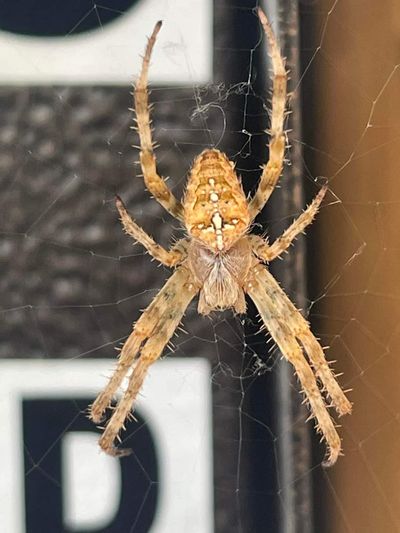Bugging the Northwest: Got web? Meet the spider that spins silk with spellbinding flair

They’ve been to space, they’ve taken drugs and oh, what a web they weave.
The spider photographed in a web affixed to some mailboxes in Port Townsend is a female cross orbweaver, according to Rod Crawford, spider expert at the University of Washington’s Burke Museum in Seattle. Scientifically known as Araneus diadematus, the species is widely recognized as a web-spinner extraordinaire, so much so that it has been the subject of thousands of studies, he said.
“It is the one spider on Earth that has spent the most time being studied in biology labs,” he said. “Look up the scientific name on Google Scholar and you’ll get over 5,000 scientific papers.”
Female cross orbweavers build those flat, circular spiral webs that humans like to depict as Halloween decorations. Perhaps you’re starting to see these classic spider webs in gardens, along fences, descending from roof gutters, stretched between trees. And there just might be an orbweaver stationed near the hub of a web, waiting patiently for prey.
“By this point in the year, I start getting calls asking ‘Why are there so many spiders all of a sudden?’ ” Crawford said.
No, it’s not an overnight infestation, he assures people, adding that the cross orbweavers have been hanging around outdoors all summer. Having grown rapidly through late summer, they’re simply more visible now because their bodies and webs are approaching their largest size.
Does this mean they can hurt you?
“No orbweaver whatsoever poses any danger to humans,” Crawford said. Instead, they pose a danger to the insects that get ensnared in their webs and eaten, which, it turns out, is a good thing for humans.
“Orbweavers are a big help to gardeners, catching many dispersing winged aphids, among other pests,” he said.
Scientific interest in cross orbweavers and their geometrical webs goes back decades. Some of the research has been, well, out there.
Starting in the late 1940s, British pharmacologist Peter Witt dosed them with drugs ranging from amphetamines to mescaline and LSD. The drugged spiders still wove their webs, but with helter-skelter patterns. In 1973, two female cross orbweavers became the first spiders in space when NASA launched them to the U.S. space station Skylab to see if they could spin webs in a weightless environment. After spinning several webs with “significantly finer” silk threads than those produced on earth, the two died before the mission was completed, according to a 1976 paper in the Journal of Arachnology.
And one more thing about these spiders’ large, intricate webs. To make up for their poor eyesight, cross orbweavers “tune” their silk threads to vibrate in different frequencies to help them identify and locate prey and potential mates entering their webs, according to current research.
Since courtships take place in the web, approaching males actually pluck the threads a specific way to signal to the larger female that “he’s a suitor, not prey,” said Crawford.
Think of it as a guitar strum. If the female approves of the vibrations, she’ll probably decide to mate with the suitor. If not, she might eat him.